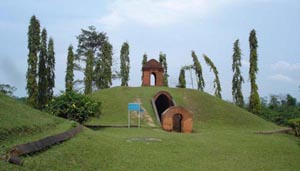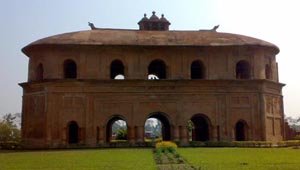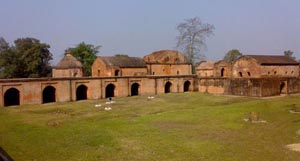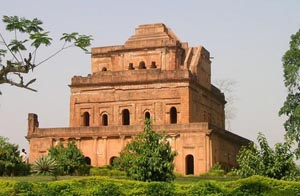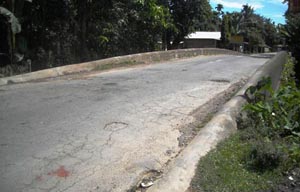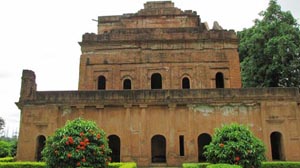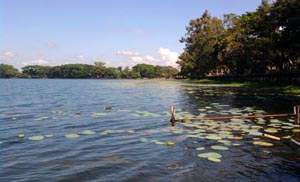Assam Monuments - Famous Historical Places, Forts & Palaces
List of names of Famous Historical Forts / Palaces / Places of Assam State
Here you can find list of names and information on historical forts / palaces/ places / monuments in Assam, India. These famous monuments of Assam state are most visited and most sought after best tourist places. You can also find images of Assam monuments / places / forts / palaces.
Sivasagar Monuments, Assam »
Charaideo Maidam which is renowned as pyramids of Sivasagar in Assam is amongst the most historical sites where emperors of Ahom Dynasty shared their heyday during the time of their control. Throughout the time of 1229 CE Charaideo was a royal seat of Ahom and maidams of it was built by Chaolung Sukhapa. It is very important to note that Ahom were active in shifting their capital states but still an essence of Charaideo remains eternal within the pages of history because it was the first capital of the Ahom Dynasty.
Rang Ghar of Ahom dynasty which is often regarded as Colosseum of the east is an oldest amphitheater within entire Asia. Perched perfectly within the district of Sivasagar, Assam the two storied complex of Rang Ghar was the royal venue where emperors along with his family used to come to witness vivid excitement of games. Construction of the Amphitheatre reveals the fact of Ahom dynasty regarding their interest towards games and their presence certainly supports the fact they were great admirer and supporter of the same.
The Talatal Ghar is considered to be amongst the largest historical monuments in Assam. It is situated in Rangpur that is 4 kilometres away from Sivasagar which is supposed to be the present name of Rangpur. The Talatal Ghar was originally constructed for the purpose of using it as a base for the army. The structure was constructed by Rajeswar Singha who was an Ahom king. The Talatal Ghar along with its complementing structure above the ground that is the Kareng Ghar is supposed to be one of the finest instances of Ahom architecture.
Architecturally, the fort and the palace show the rich skills of the Ahom kingdom. There was a Solang ghar within the palace which was used by the rajas an audience hall to address the people of the kingdom. It was 120 cubits long and a width of 30 cubits. It is known that the entire structure is supported by around 66 pillars. This aspect shows that the palace was quite strong in its own sense. The entire mansion was complete with the use of 12,000 workers which is a record of its own.
Architecturally, the bridge is deemed to be a masterpiece with numerous attractive features associated with it. Notably, the bridge was built entirely with the use of stone but the aspect that can amaze anyone is the fact that it was constructed only with one single stone which more that hundred of year of age during the time of construction. The bridge was built on the basis of the Arch bridge style by the craftsman of Bengal. The total length of the structure is around 60 m and its overall width is 6.5 m.
With regard to architecture the Ahom kings are always known for their efficient and effective work in the past and it is no different in the case of Kareng Ghar. The interior of monument has been largely designed on the basis of local architectural style. The monuments has a four storey structure arranged gradually. The completion of the monument was seen under the reign of Swargadeo Rajesh and his successor during 1751- 1769 AD. The top floor was designed in the form of a chamber.
Architecturally, the tank is a masterpiece in its own manner. Despite of the fact that the tank is more than 200 years of age, one cannot visually understand that it was made in the absence of any technological support. The tank has a depth of around 64 feet which is quite deep indeed. It will be vital to mention that the embankment of the tank is artificial and raised the surface of water to height of around 40 feet from the surrounding plain.
- Andaman Nicobar Monuments
- Andhra Pradesh Monuments
- Assam Monuments
- Bihar Monuments
- Chhattisgarh Monuments
- New Delhi Monuments
- Goa Monuments
- Gujarat Monuments
- Haryana Monuments
- Himachal Pradesh Monuments
- Jammu and Kashmir Monuments
- Karnataka Monuments
- Kerala Monuments
- Madhya Pradesh Monuments
- Maharashtra Monuments
- Odisha Monuments
- Punjab Monuments
- Rajasthan Monuments
- Tamil Nadu Monuments
- Telangana Monuments
- Uttar Pradesh Monuments
- West Bengal Monuments
